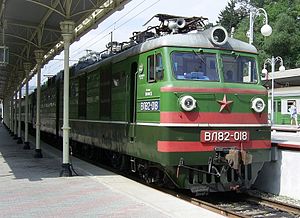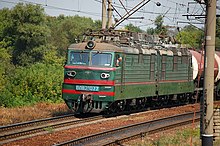SŽD series ВЛ82
| SŽD series ВЛ82 (WL82) | |
|---|---|
|
ВЛ82.018
|
|
| Numbering: | different numbering |
| Number: | 91 |
| Manufacturer: | Electric locomotive factory Novocherkassk |
| Year of construction (s): | 1966-1979 |
| Axis formula : | Bo'Bo '+ Bo'Bo' |
| Gauge : | 1,520 mm |
| Service mass: | ВЛ82: 188 t ВЛ82 m : 200 t |
| Top speed: | 110 km / h |
| Hourly output : | 5,600 kW |
| Power system : | 3 kV = 25 kV 50 Hz ~ |
| Number of traction motors: | 8th |
The SŽD series ВЛ82 (German transcription WL 82) of the Soviet Railways (SŽD) is an eight-axle freight train - electric locomotive for the two power systems 3 kV = and 25 kV 50 Hz ~ . It was developed from the ВЛ80 c for operation on main roads that include a change in the power system, and where a system separation point in a system change station is not economically advantageous.
History and construction
The first test locomotives of the two-system locomotives with eight axles, the ВЛ82.001 and ВЛ82.002 , were built in July 1966 by the Novocherkassk electric locomotive factory . In terms of structure, they represented an electric locomotive with direct current with an additional transformer and rectifier for operation on lines with alternating current . The majority of the elements of the mechanical structure were the same as those of the ВЛ80 k . It is therefore also a two-section locomotive.
A transformer from the production of the Electronic Works in Tallinn is installed on each section of the electric locomotive . The mass of the transformer with oil is 5800 kg. The six-pole traction drive motors НБ-420А ( NB-420A ) were specially designed for this and other electric locomotives. They have a mass of 4500 kg. Two motor fans are installed on each section for cooling. There are also two motor fans for the electric brake . Each section also has a rechargeable battery. During the operation of the electric locomotives, the original traction drive motors were replaced by those that were later used on the ВЛ80 m . Each section of the locomotive has its own electrical supply that can work across multiple units. When working with alternating current , the voltage is fed to the traction motors via the transformer and the rectifier unit. When driving under direct current , it is fed directly to the drive motors. In both cases, the voltage is regulated via resistors . The locomotive has a resistance brake , and when it is used, the traction motors are connected in a cross shape. All four electric travel motors in a section can be connected in series and in parallel. The two sections can only be connected in parallel. The switching of the connection of the traction motors is controlled by resistors and carried out by an electric drive to the electric controller ЭКГ-82 ( EKG-82 ). The drive switch is the same as that of the ВЛ80 .
The auxiliary machines of each section are four motor fans МВ ( MW ), a motor compressor МК and a motor pump MH for the oil of the transformer. All machines are high-voltage DC machines with a voltage of 3000 V except for the drive for the oil pump. This is an alternating current machine and only works when driving under alternating current. It receives its power from the transformer. The motor fans МВ ( MW ) 1 and 2 are used for cooling the traction motors, the motor fans МВ ( MW ) 3 and 4 for the electric brake. They are fed when the braking current flows past. All motor fans have an electric damper that can dampen the start-up current.
After the successful testing of the ВЛ82 series electric locomotives, the Novocherkassk electric locomotive factory built 22 locomotives until 1968. Originally all locomotives were operated in the Yaroslavl area of the Severnaya schelesnaja doroga . Later they were taken to the Kupyansk depot of the Piwdenna Zaliznytsia . 1977–1980 the majority of the locomotives were moved to the Mineralnye Vody depot of Severo-Kawkasskaya zhelesnaja doroga .
ВЛ82 m
From 1972 onwards, the Nowotscherkassk electric locomotive factory produced a further developed variant of the two-system electric locomotive, which was given the designation ВЛ82 m ( WL82 m ). A total of 69 of these locomotives had been built by 1979. It differed from its predecessor in the reduced gear ratio, developed especially for its new traction drive motors НБ-407Б ( NB-407B ). The electrical scheme also underwent significant changes, the locomotive received a new drive switch, new pantographs, etc. The main difference in the electrical scheme is the electrical equipment with a group switch similar to the ВЛ10 . The locomotive body and the bogies were designed analogously to those of the ВЛ10 u or ВЛ80 T series . In the engine room, there are round windows instead of the large rectangular ones, and side supports on the bogies replace the cradle suspension.
The weight of the modified locomotives is 200 t compared to 188 t of the original ВЛ82 . Because of the greater mass of the modified locomotives, the area of application of the original locomotives also changed; Due to their tendency to skid due to their lower weight, they were used to cover passenger trains.
The locomotives of the ВЛ82 m series are operated by the Kupyansk depot of the Piwdenna Salisnyzja and the Mineralnye Vody depot of the Severo-Kawkasskaya seleznaja doroga . On the other hand, the October Railway ended the use of these locomotives to Vainikkala (Finland), which began in 1977, and is now pulling diesel locomotives across the border crossing.
Device for current determination
Both locomotive designs have the detection device for the electricity used at system separation points . Its task consists in the reliable automatic determination of the type of current (direct current or alternating current) under the pantograph of the electric locomotive and transmits signals for switching to the high voltage range. The designation is УРТ-3 ( URT-3 ). This works in pairs with the dry- type transformer ТОС-41 . Its primary winding is connected on the one hand to the roof rail of the pantograph and on the other hand to the УРТ-3 . The secondary connection of the transformer produces a voltage of 160 V and is also connected to the УРТ-3 . If a direct current of 2.2 kV - 4 kV is connected to the roof rail , current goes to the relays РВ4 and B3, which controls the current directly to the traction motors. If, on the other hand, there is alternating current on the roof rail, the transformed current, rectified via the diode blocks Д1 and Д2 , reaches the relay РВ2 , the relay РВ4 is de-energized by the 1350 turns of the transformer, the relay B3 picks up via the diode bridge Д1 and Д2 . This causes the current to flow from the high voltage chamber to the main transformer. A rectifier bridge Д3 serves to separate these control circuits.
The control unit УРТ-3 is on a plastic panel , the transformer is mounted separately.



